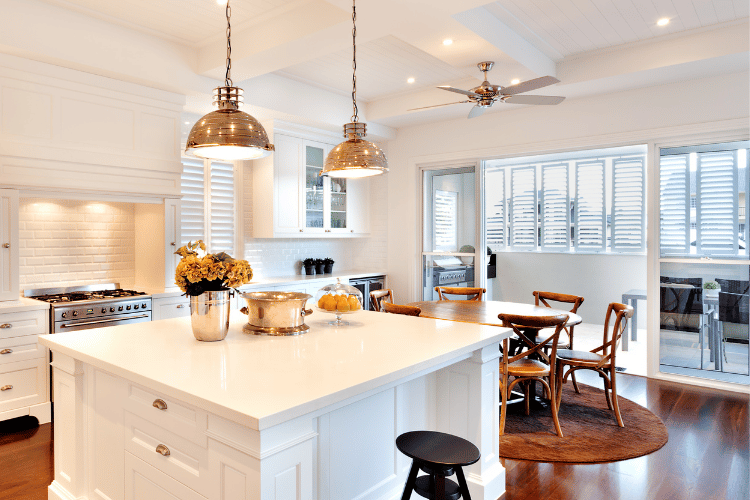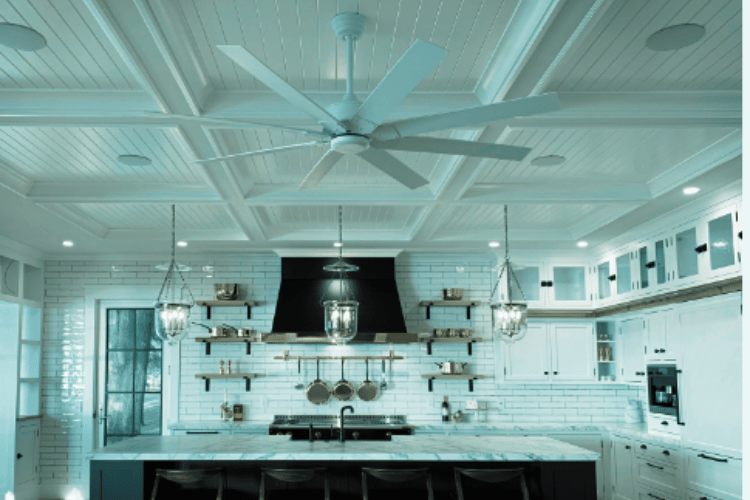The kitchen is often considered the heart of the home, a place where families gather, and culinary magic happens. But, as much as we love our kitchens, they can get hot and stuffy, especially during the summer months. That’s where a ceiling fan in kitchen can make a world of difference. In this comprehensive guide for 2023, we will explore everything you need to know about ceiling fans in the kitchens, from installation tips to the latest design trends. Whether you’re looking to improve ventilation, save on energy bills, or add a touch of style to your kitchen, we’ve got you covered.
Why Install a Ceiling Fan In Kitchen?
Installing an Overhead Fan in the Kitchen is a smart choice for several reasons. Firstly, it improves air circulation, keeping the space comfortable and preventing heat and cooking odors from accumulating. Secondly, it’s energy-efficient, consuming less power than air conditioners, which saves on energy costs. Thirdly, many air circulators offer year-round comfort with reverse functions for both summer cooling and winter warmth distribution. Lastly, the variety of stylish designs and finishes allows you to enhance your kitchen’s aesthetics. So, a kitchen breeze maker not only provides practical benefits but also contributes to a more inviting and efficient culinary environment.
Choosing a Kitchen Roof Fan
- Size Matters: The first thing to consider is the size of your kitchen. For smaller kitchens, a compact fan with a blade span of 36-48 inches should suffice, while larger kitchens may require fans with a 52-inch or larger span.
- Ceiling Height: Ceiling height is crucial when installing a ceiling fan. For standard 8-foot ceilings, a flush-mount fan is ideal, while higher ceilings may require a down rod for proper clearance.
- Blade Design: The design of the fan blades can impact both aesthetics and performance. Opt for blades that complement your kitchen’s style while ensuring they are pitched at an angle that provides efficient airflow.
- Lighting Options: If your kitchen lacks sufficient lighting, consider a ceiling fan with integrated light fixtures or the option to add them.
- Motor Quality: A high-quality motor is essential for a ceiling fan’s performance. Look for fans with energy-efficient motors that are both quiet and durable. A good motor ensures that your fan will operate smoothly and efficiently for years to come.
- Energy Efficiency: Look for the ENERGY STAR label to ensure your fan is energy-efficient. Additionally, consider fans with DC motors, which are known for their energy-saving capabilities.
Ceiling Fans vs. Air Conditioners in the Kitchens
Ceiling fans and air conditioners both have their roles in keeping your kitchen comfortable. Air circulators are energy-efficient, provide even air circulation, and can be used year-round. They’re great for mild heat and improving ventilation. On the other hand, air conditioners offer powerful cooling but consume more energy. They’re ideal for extreme heat and can rapidly cool down the kitchen. However, they might not provide the same distribution of air as kitchen hood fans. The choice between a ceiling air circulator and an air conditioner depends on your climate, energy efficiency concerns, and personal comfort preferences. Some even opt for a combination of both to strike the perfect balance.
Kitchen Overhead Air Circulator Design Trends
- Minimalist Design: Clean lines and simple aesthetics are in. Many homeowners are opting for blower with understated designs that blend seamlessly with their kitchen decor.
- Matte Finishes: Matte black, white, and brushed nickel finishes are gaining popularity, adding a touch of modern sophistication to kitchens.
- Smart Fans: Smart kitchen fans with Wi-Fi connectivity and voice control capabilities are on the rise, allowing you to control your fan with ease.
- Wood-Blade Fans: Fans with wooden blades are making a comeback, bringing a natural, rustic charm to kitchen spaces.
- LED Lighting: Blowers with integrated LED lighting are not only energy-efficient but also provide a sleek and contemporary look.
- Customization: Many manufacturers now offer customization options, allowing you to choose blade finishes, fan sizes, and lighting options that suit your kitchen’s unique style.
Importance of Culinary Room Blower
Having a fan in the foodie haven offers numerous benefits. It enhances air circulation, keeping the kitchen cooler and fresher during cooking. Ceiling air blowers are energy-efficient, reducing cooling costs. They provide year-round comfort by circulating warm air in the winter. Stylish and customizable, they come in various designs to match your food lab decor. Additionally, ceiling fans can include built-in lighting, improving visibility while cooking. Overall, an air blower is a practical and aesthetic addition to any cookery, enhancing comfort, energy efficiency, and ambiance.

Installing a Cuisine Room Roof Fan: DIY Guide
If you’re a handy homeowner, you might consider installing your kitchen air mover yourself.
- Turn off Power: Safety first! Turn off the power to the existing ceiling fixture at the circuit breaker.
- Remove the Old Fixture: Carefully remove the existing light fixture or fan, disconnecting the wires. If you’re unsure, consult an electrician.
- Install the Mounting Bracket: Follow the manufacturer’s instructions to install the mounting bracket to the ceiling box.
- Attach the Fan Motor: Attach the fan motor to the mounting bracket, following the provided instructions.
- Connect Wiring: Connect the wiring from the fan to your home’s electrical wiring, matching colors (e.g., black to black, white to white, etc.).
- Attach Blades: Attach the fan blades to the motor following the manufacturer’s instructions.
- Add Light Kit (if applicable): If your fan has an integrated light kit, attach it as instructed.
- Secure Everything: Double-check that all connections are secure and tighten any loose screws.
- Turn the Power Back on Finally, turn the power back on at the circuit breaker and test your new kitchen air mover.
Ceiling Fan in a Kitchen Compared To Traditional Cooling Methods
A roof air circulator in the kitchen offers several advantages over traditional cooling methods. Unlike air conditioners, top fans consume significantly less energy, resulting in lower electricity bills. They create a cooling sensation by circulating air, making the kitchen feel more comfortable without decreasing the room’s temperature. Additionally, roof fans can be used year-round, with a reverse function that helps distribute warm air during colder months, improving overall energy efficiency. They are also quieter than air conditioners, preserving a peaceful atmosphere. Overall, a ceiling air mover in the kitchen provides a cost-effective, energy-efficient, and versatile cooling solution when compared to traditional methods like air conditioning.
Conclusion: Ceiling Fan in Kitchen
A roof fan in the kitchen isn’t just a functional addition; it’s a design statement and a way to make your kitchen more comfortable year-round. With the latest trends in mind and a bit of DIY spirit, you can transform your kitchen into a stylish and refreshing space. Whether you opt for a smart fan with all the bells and whistles or a classic wood-blade design, a kitchen roof fan is a worthwhile investment that will enhance your home’s aesthetics and energy efficiency. Stay cool, save on energy bills, and enjoy your kitchen to the fullest with the perfect fan for your space in 2023.
FAQs
Where’s the Best Spot for Your Kitchen Blower?
The best spot for your kitchen Blower is typically in the center of the room, ensuring even airflow. If your kitchen is larger, consider installing multiple fans or a larger fan for adequate circulation. Ensure proper clearance from any obstructions like cabinets or lighting fixtures for optimal performance.
Is it safe to use a fan in a kitchen?
Yes, it is safe to use an electric fan in the kitchen as long as it is installed correctly and complies with safety guidelines. Ensure the fan is positioned at a safe height, away from any obstacles, and follow proper installation procedures. Keep it clean to prevent dust buildup, which can affect performance.
Are there any innovative features or technologies in modern kitchen electric fans that homeowners should be aware of in 2023?
Yes, in 2023, modern galley ceiling air circulators offer innovative features like smart connectivity, allowing remote control via smartphones or voice assistants. Some fans have built-in air purifiers to enhance indoor air quality. Additionally, energy-efficient DC motors are becoming more prevalent, reducing energy consumption and operational costs while providing quieter operation. Keep an eye out for these advancements when choosing a ceiling fan for your cookery.
How can proper ventilation, aided by an Air circulator, contribute to a healthier and more comfortable kitchen environment?
Proper ventilation, with the assistance of an air circulator, removes cooking odors, excess moisture, and pollutants from the kitchen. This prevents the buildup of mold, mildew, and harmful indoor air pollutants, promoting a healthier indoor environment. Additionally, improved air circulation helps maintain a more comfortable temperature, reducing heat and humidity levels, and making cooking easier. Lastly, dining in the cookroom is more enjoyable.


